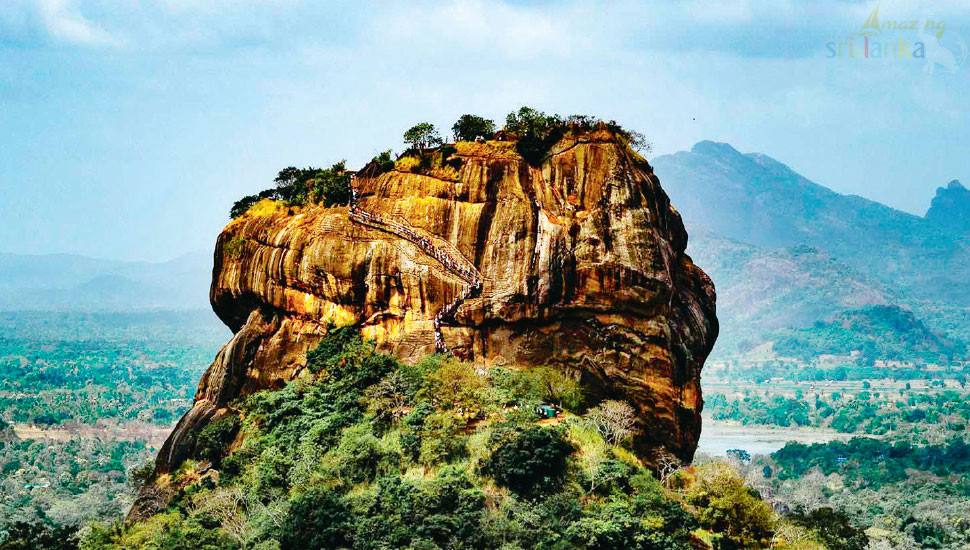In Search of the Lion at Sigiriya – Part 2

In Search of the Lion at Sigiriya by Ama H.Vanniarachchy
Part 2
Anuradhapura 5th century CE
Royal assassinations and betrayals…
The well-known physician king Buddhadhasa’s son Upatissa was reigning as king when he was assassinated by his own queen in 412 CE. The Mahavamsa (second-half) says, she had an affair with the king’s brother Mahanama. After the king was killed, Mahanama who was a monk, took up the throne.
After the death of Mahanama, his son of a second queen, Soththisena (Sengoth) ascended the throne, only to be killed by his half-sister, Sangha, daughter of the chief queen. Her husband was crowned as king, but died after a year. After the king died, the ministers decided to keep it as a secret from the public. Therefore, the public was told that the king was sick while the dead king was cremated in utter secrecy in the inner city and a man named Mittasena Karalsora, was crowned as king. After some time, the people protested. They wanted their king to appear in front of them. Mittasena came all decked up with royal attire. However, the chronicles say that the royal tusker refused to let Mittasena ride him. During his reign the Sinhala throne was usurped by invaders from South India. This was in 436 CE.
Who were these invaders?
During this period, most of the Tamil country was under the rule of the Kalabhra Empire. They were also known as the Kalabrar, Kalvar or the Kalappirar, and little is known about them. Scholars speculate that they were supporters of Buddhism and Jainism.
As the Pali Chroniclers say, Dhatusena, a descendant of the Moriya clan, came into power ending the rule of the usurpers. It is generally believed that Dhatusena was the nephew of Mahanama Thera, the great chronicler, or the compiler of the Mahavamsa.
After Dhatusena became king, the Sinhala kingdom witnessed a prosperous time. Trade flourished and the kingdom was amongst the wealthiest of the region at that time.
Now, as the Pali Chronicler says the tragedy of Sigiriya happened when the power hungry Kasyapa killed his own father and built a fortress in Sigiriya as he feared his brother Moggallana.
Kasyapa being accused for centuries…
For centuries Kasyapa was accused of patricide. He was portrayed as a man who ascended to the throne wrongfully by being unjust to the rightful king; as a man who was born to a lesser queen. And Moggallana has being portrayed as the rightful and peaceful king, a protector of Buddhism. However, the chronicle never failed to acknowledge how Kasyapa was a patron of Buddhism and ruled as a true Buddhist ruler. But, the Pali Chronicle never did justice to Sigiriya. The mentioning of such a great wonder, a masterpiece, is only confined to a few lines.
Who wrote the second half of Mahavamsa?
The second half of the Mahavamsa was compiled by a monk named Dhammakitti in the 13th century, eight hundred years after Kasyapa.
Doubts…
Immurement, how Kasyapa killed his own father as the Pali Chronicle says, was a practice of killing people as punishment in ancient Persia, Assyria, the Mediterranean, Rome, the Mogul Empire, China, and in the Ancient South America. It was not a common or known practice of punishment among the ancient Sinhalese.
Another point that should be noted is that, the remains of Sigiriya are rather a palace and a pleasure garden than a fortress. Also, it is not practical to believe that anyone can built such a massive construction to hide out of fear as the chronicle says, in a very short period of time.
Sigiriya, the abode of a god-king
The ruins of Sigiriya suggest something else. It is unique and completely alien to the usual style of royal palaces of Anuradhapura. A man who was shivering with fear and looking for a place to hide cannot build a well-planned palace like Sigiriya.
Building a royal palace on top of a massive rock and that too in majestic style adding gigantic lions and hundreds of painted figures, with water gardens, is not something previous monarchs did in Anuradhapura. A palace on top of a rock is a gateway to heaven, close to the gods and which makes the king who lives there a god. This concept of ‘god-king’, was something different and new to the kingship of the island.
The Pali Chronicle says that Kasyapa lived like Kuvera in Alakamandawa. Never before has the chronicle nor inscriptions compared a Sinhalese king to Kuvera. Kuvera or Kubera, the god of wealth is known to be the king of Yakkas, a semi-god or a god-king living in Alaka or Alakamandawa. He is also a protector of Buddhism and a Bodhisattva in Mahayana. His two chief guards, Sankha and Padma bhahirawas are common in ancient Sinhalese arts. In mythology, he is also known as Vaissravana, or Vessavana, and the grandson of Rishi Pulasthi. We have featured Pulasthi in one of our previous Heritage feature stories.
Prof. Paranavithana sorts some of the missing parts of this jigsaw puzzle…
He discovered new documents in the year 1964 while going through some of the ancient inscriptions. According to the genius, these new documents were written in Sanskrit and introduced to Sri Lanka during the 15th century, by Ananda sthavira (Buddhamitra of Suvarnapura). The then reigning king Parakramabahu VI ordered them to be inscribed in ancient inscriptions in Rajarata. These documents were believed to be written far before the second half of the Mahavamsa was committed to be written.
According to ‘The Story of Sigiri…’
Bloodline of Kasyapa
Sangha, daughter of the Sinhala king Mahanama was married to Balapraya, king of Pundra; an Indo-Greek dynasty. Dhatusena was the son of Sangha and Balapraya. As Mahanama died, Sangha arrived in Anuradhapura, assassinated her half-brother Sena and crowned seven-year-old Dhatusena as king. A general named Kalabhreshvara was appointed to rule. The Pali Chronicle refers to him as Mittasena Karalsora. During his time, invaders from India usurped the throne. After battling them for many years and overcoming many political hurdles, Dhatusena was crowned as the king of Anuradhapura. He was also king at Pundra.
His first wife was the sister of the Pallava king, Queen Partha. Their son was named Kasyapa. Dhatusena’s sister was married to a Pallava general Migara.
While in Anuradhapura, he married Sangha, daughter of Svatisena (assassinated by Dhatusena’s mother).
Dhatusena wanted more power in the region
Dhatusena was a powerful ruler in the Asian region. His great irrigation work helped the country to flourish in agriculture. However, his hunger for more power created rifts between him and neighbouring kingdoms.
Maga from Persia…
Meanwhile a Brahmin called Maga from Persia arrived at Anuradhapura. Taking advantage of the king’s stress and hunger for more power, Maga, brainwashed the king. It was Maga who told Dhatusena to become a Parvatharaja like the kings in Persia. Maga said, a Parvataraja ruled his kingdom while residing in a palace built on the summit of a rock.
He also said that the founder of the royal house of Persia was a Parvataraja and the name of his descendant was Kuvera (Cyrus). (The father of Cyrus I and II was Cambyses and numerous scholars link Cambyses to the Sanskrit tribal name Kambojas)
Dhatusena ill-treated Kasyapa…
Dhatusena was in favour of Moggallana. Thinking, “Let Kasyapa do or die,” Dathusena sent Kasyapa to war with the Pallavas. However, Kasyapa being a great warrior defeated the Pallava army led by Migara.
Meanwhile Dhatusena was reluctant to appoint Kasyapa as the Yuvaraja. Therefore the disappointed young prince decided to leave the country. At this moment he heard of a conspiracy against him by his own family. Kasyapa with the help of his uncle who was the king of Pundra, returned to the island with an army.
Death of Dhatusena: suicide not patricide
Kasyapa was expecting Moggallana to fight him. Unknowing that his own father who was old and weak was about to battle him, Kasyapa attacked the rival army. Seeing his army had been decimated, Dhatusena cut off his head with his own hand and died on the battle field.
Kasyapa and Sigiriya
Kasyapa was crowned as the king while Moggallana and his mother fled the country. He lived among the primitive tribes in Suvarnapura.
Seeing the rock named Akasaparvata, the place where Dhatusena had begun to build a palace on the summit, Kasyapa decided to continue with the construction. He built it as the abode of Kuvera, and it says that it took seven years to complete Sigiriya. He built a gigantic lion’s paws and head in the palace which gave the rock its name; Sihagiri.
Kasyapa maintained good political alliances with neighbouring countries and trade prospered under him. Archaeological evidences prove that international trade flourished during this period.
Betrayed by his own queen…
Kasyapa’s queen was the daughter of Dhatusena’s sister. She was also the sister of Migara. Migara had sworn revenge against Kasyapa. Thus, the brother and sister conspired against Kasyapa.
He was assassinated at the Plateau of Read Arsenic (the area in front of the lion’s paws) at Sigiriya.
Kasyapa’s son
Moggallana was still in Suvarnapura. After Kasyapa’s death, generals appointed six-year- old Dhatusena, son of Kasyapa as king.
Moggallana returns
Hearing the arrival of Moggallana, Kasyapa’s most faithful general Sulaksmana went to battle with him. On his way, he saw a vast spread swamp and ordered his army to take another road. The captain of the army, maybe misunderstanding the order or intentionally, deserted the general and joined Moggallana. The faithful general severed his head with his own hands (Pali Chronicles narrated the death of Kasyapa similarly).
As there was no one to protect him, the boy king Dhatusena, fled to Pundra and lived there till his death.
Moggallana loses his mind…
Living 18 years of exile among primitive tribes and facing humiliation, Moggallana had lost his mind. Kasyapa’s widowed queen ascended the throne while Moggallana proved his insanity. He lit a fire in Anuradhapura and burned those who were in favour of Kasyapa alive. He also ordered the Bodhi tree to be destroyed. At this juncture the Queen Mother came forward and stopped him. Annoyed by her, Moggallana gave orders to kill the queen. Realising that the king has crossed all limits, soldiers put priest Maga (the priest who misled Moggallana), to the inferno. Then the Queen Mother and monks of Mahavihara intervened and calmed the king. It is said that, Mahanama Thera, author of the Mahavamsa, intervened at the end and calmed Moggallana and he finally embraced Buddhism.
The Mahavamsa (second half) also records how brutal Moggallana was. It says that he killed more than thousand men who favoured Kasyapa and tortured many. Therefore he was called, ‘The Demon’.
To be continued…
The original link was first published on
https://ceylontoday.lk/news/in-search-of-the-lion-at-sigiriya-1
Uncategorized, Kashyapa, Sigiriya, Sri Lankan archaeology, SRI LANKAN HISTORY
